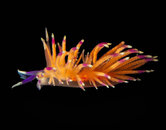OP
GuinnessDrnkr
Registered
It took me a few days to adjust distances compared to the 60mm. I was always too close to the subject at the start and had to back off a few inches. The focus limiter options on the lens are also a huge boon.Gorgeous. I would love to spend a few weeks there with a macro set up
Compared to the 60 mm how much further away can you get with the 90 mm (say for example on that last nudibranch?)
At the infinity setting, closest is about 9.5" from the lens and actually allows for portrait/ID shots. The challenge there is that silty conditions mean a lot of hunting for the AF. If I was swimming around looking for something I would leave the lens on this setting, "just in case" something came out of nowhere and the camera managed to focus on the subject and not particulate matter in the water. I was surprised at how well it worked (when it worked) and would have loved for some clear conditions to really see what it could do.
The super macro was where I spent 90% of my time given the visibility challenges. Distance for that is maybe an extra inch or two compared to the 60mm. Rough estimate is that I was typically 4-6" away. Holding still is always the challenge, but when it all works the clarity and magnification is amazing.
My usual process was to start at the infinity limit and if the subject let me, I would drop to the .25m - .5m focus limit and creep in. If it was a slow-mover I would typically immediately jump to super macro.
Now that I'm more familiar with the lens I'll try manual focus next time. It's an either/or option for this lens given the clutch.




